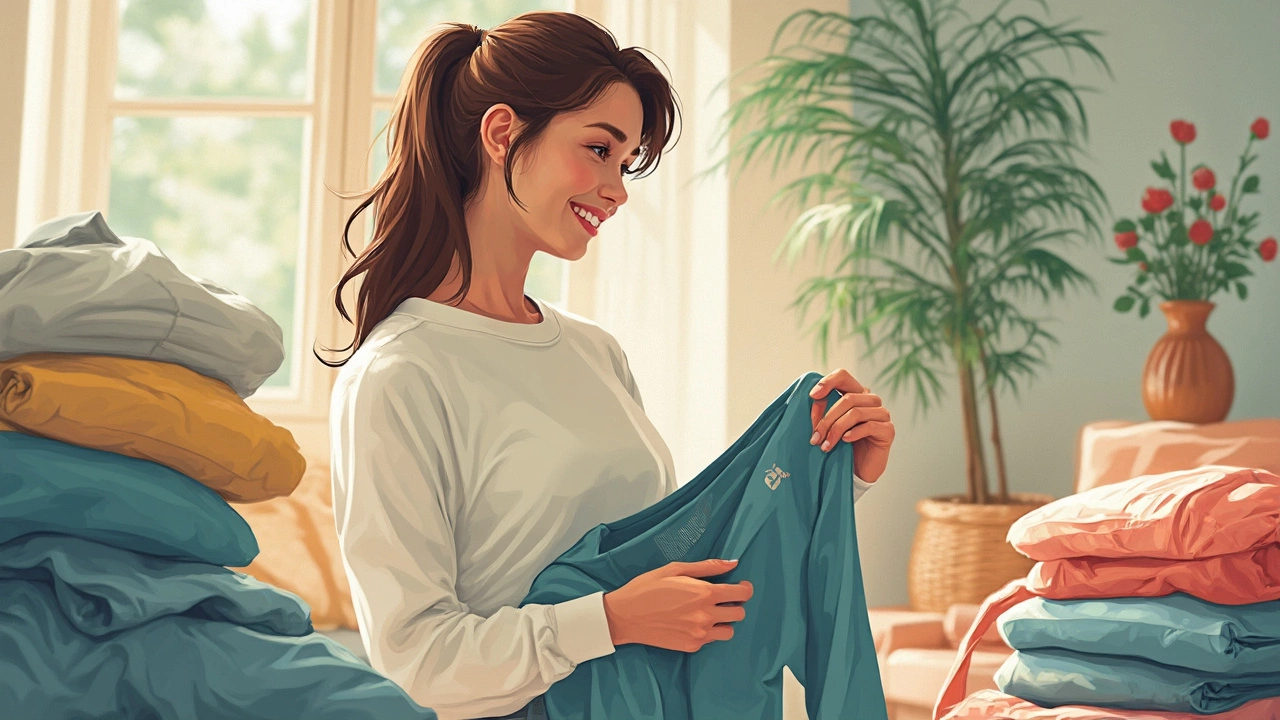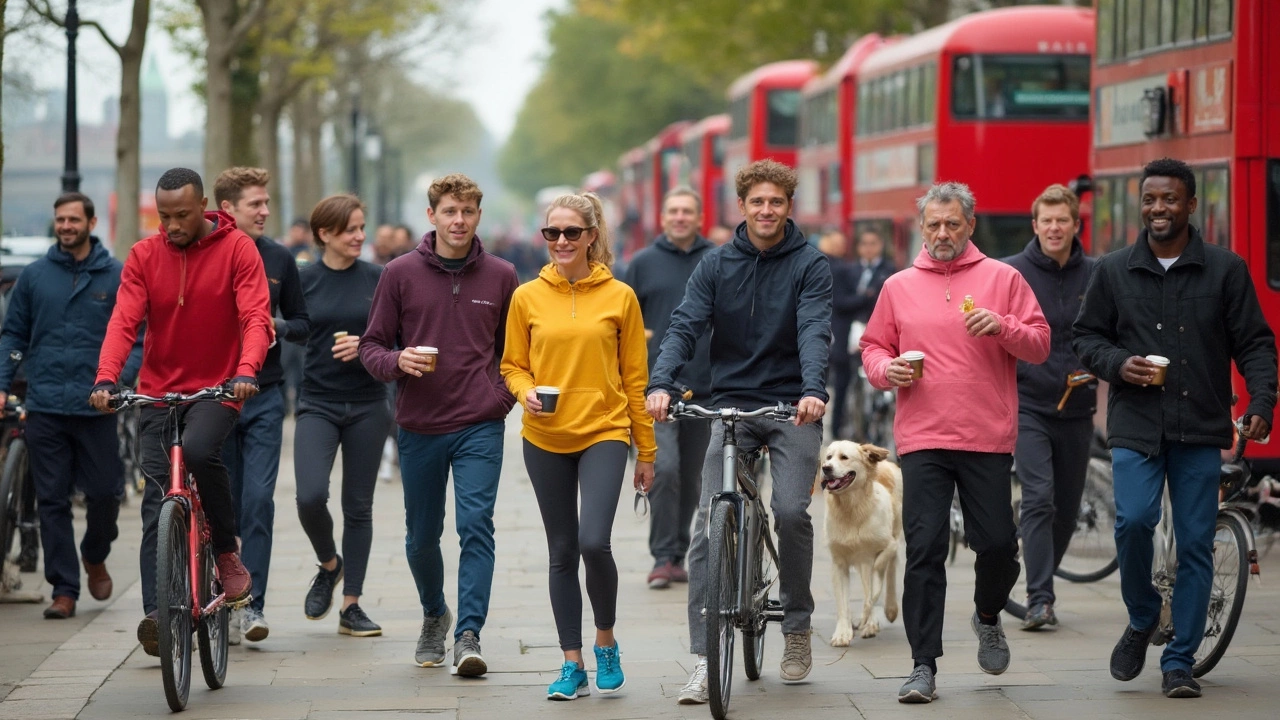So, what exactly counts as activewear? Surprisingly, it's not just anything stretchy or labeled "sports." There's actually a pretty clear line between gym gear and what you'd lounge in at home. Activewear is all about supporting movement without getting in your way. It covers clothes built for exercise—think leggings that wick away sweat, breathable tops that don't feel heavy, and sneakers designed for workouts, not just walking the dog.
Quality activewear gives you freedom to move, whether you're hitting the gym, going for a hike, or even just doing yoga in your living room. The focus? Comfort and practicality—no pinching seams or bulky zippers. If you ever wondered why that old cotton tee turns into a soggy mess when you run, it's because real activewear uses special fabrics that pull sweat away and dry fast. That means no distracting chafing or sticky shirts, making your workout feel smoother from start to finish.
- Defining Activewear
- Key Features that Set It Apart
- Types of Activewear for Every Activity
- When to Wear Activewear (and When Not To)
- Smart Shopping: Tips for Picking the Best Activewear
Defining Activewear
If you’re picturing just workout clothes, you’re on the right track, but activewear covers a bigger slice of your closet. Here’s the deal: activewear is designed specifically for physical activities. That means everything is built with comfort, support, and movement in mind. You won’t see stiff collars or itchy fabrics here—just gear that makes it easier to get up and move.
What counts? The obvious stuff—like stretchy yoga pants, moisture-wicking shorts, or sports bras with solid support. But it also includes items for more chill activities, like athleisure hoodies or quick-dry running hats. If it helps you move better while sweating (or even if you’re running errands after), it probably fits under this umbrella.
- Made with performance fabrics: Think polyester, spandex, or nylon. These pull sweat away, breathe easy, and often have a bit of stretch for flexibility.
- Seam and fit matter: Good activewear uses flat seams and ergonomic designs, so nothing digs or rubs in the wrong place during movement.
- Function over fashion (usually): While a lot of activewear looks great, it’s first about how it handles activity—durability, stretch, breathability, and quick drying always come first.
Don’t confuse activewear with regular everyday clothes or even some casual "sportswear". Many brands blur this line, but true activewear is always ready for real movement, whether that’s a bike ride or just chasing your dog in the park.
Key Features that Set It Apart
All activewear isn’t created equal. What gives these clothes their edge are a handful of smart, practical features you won’t always find in your regular wardrobe. Forget cotton basics that get heavy and soaked—activewear is purpose-built from the thread up to support your body when you’re moving hard or sweating a lot.
The most noticeable difference is the fabric. Most real activewear is made with synthetic materials like polyester, nylon, or spandex. These fabrics are famous for wicking moisture away fast, so you’re not left with a clingy, wet shirt. Good activewear also stretches well, which means your clothes move with you, not against you. Seam placement is another dealbreaker: flatlock or bonded seams help prevent chafing during runs or HIIT sessions.
- Moisture-wicking: Draws sweat away from your skin and dries quickly. This keeps you comfortable, even if you’re doing burpees or long-distance cycling.
- Lightweight and Breathable: Allows air to get in and heat to escape, so you don’t overheat.
- Stretch Factor: Look for at least a bit of spandex or elastane. This gives flexibility for moves like squats or stretches without feeling tight.
- Durability: Reinforced stitching helps gear hold up to repeated wear and heavy washes. You want your leggings to last more than one yoga class, right?
- Odor Control: Some brands add anti-microbial finishes that fight bacteria and smells, so you don’t clear the room after a tough session.
- Pockets & Extras: Zippered pockets, headphone loops, thumbholes—small touches, huge impact. They let you stash keys or adjust easily on the fly.
Just how different can fabrics be? Have a look at this quick comparison:
| Material | Moisture Management | Stretch | Dry Time | Odor Control |
|---|---|---|---|---|
| Polyester | Excellent | Good | Fast | Low |
| Spandex | Good | Great | Fast | Low |
| Cotton | Poor | Average | Slow | Average |
| Merino Wool | Good | Good | Medium | Excellent |
This table pretty much tells you why most gym gear skips pure cotton. And if you’re working out outdoors, look for extras like UPF protection or wind resistance built right into the material.

Types of Activewear for Every Activity
Activewear isn’t one-size-fits-all. What you wear for a spin class is different from what you’d choose for a hike or a swim. Picking the right gear makes a real difference in comfort and performance. Let’s break down which pieces work best for specific activities—and what sets them apart from regular clothes.
- Leggings and Yoga Pants: If you’re big on yoga, pilates, or barre, stretchy leggings with four-way stretch and moisture-wicking fabric are your best friend. Look for flat seams so nothing digs in, and a high waist so there’s no slipping as you move.
- Running Shorts and Compression Gear: For running, opt for lightweight mesh shorts or compression tights that reduce muscle vibration and soreness. Many runners swear by gear with built-in liners and handy pockets for keys or energy gels.
- Sports Bras: No matter the activity, support is huge. For high-impact sports like HIIT or soccer, go with sports bras featuring wide straps and solid band support. For lighter activities, seamless styles do the trick.
- Performance T-Shirts and Tanks: Unlike cotton tees, these tops use technical fabrics to breathe and move sweat away from your skin. Brands like Nike, Adidas, and Lululemon lead the way here.
- Outer Layers: If you exercise outside, look for lightweight jackets or hoodies built for weather. Windbreakers and water-repellent zip-ups help keep you moving no matter what’s happening outside.
- Footwear: Running shoes, cross-trainers, and hiking boots all offer different support and tread. For cycling, you’ll even find shoes that attach to the pedals.
- Swimwear: Chlorine-resistant fabrics and snug fit are key for pool workouts. Avoid regular swimsuits—they wear out faster and don’t hold up to serious laps.
"The right activewear isn’t just about looks—it’s about giving your body the backup it needs to perform and recover," says athletic apparel specialist Jamie Hough. "Quality materials make all the difference when you’re pushing through a tough session."
Let’s compare what’s needed for some common activities. Check out this table showing must-have features for different types of activewear:
| Activity | Recommended Activewear | Key Features |
|---|---|---|
| Running | Moisture-wicking tops, compression leggings, supportive sneakers | Breathability, sweat management, joint support |
| Yoga | Stretch leggings, seamless tank, light jacket | Flexibility, non-restrictive, soft seams |
| Swimming | Performance swimsuit, swim cap, goggles | Chlorine resistance, snug fit, quick-dry |
| Hiking | Layered shirts, durable pants, hiking boots | Weatherproofing, support, durability |
Getting the right gear doesn’t mean buying a separate outfit for every hobby, but wearing activity-specific pieces really does pay off. The right support, fabrics, and fit keep you comfortable and safe, whether you’re indoors or outside.
When to Wear Activewear (and When Not To)
Activewear is made to move with you, and that's its true superpower. Obviously, you'll want to reach for activewear when you're working out at the gym, running, cycling, hiking, or getting into yoga. But there are plenty of moments when tossing on those comfy leggings or that sweat-wicking tee just makes everyday life easier—think school drop-offs, running errands, or chasing after kids at the park.
Here are the best times to wear activewear:
- Any physical activity: weightlifting, cardio, dance classes, and more
- Outdoor sports and hikes, since many pieces offer UV protection and are built to handle sweat and dirt
- Travel or long flights, because stretchy waistbands and soft fabrics keep you comfortable
- Loungewear days or casual meet-ups, as long as the style is right for where you’re going
On the flip side, there are moments where activewear just isn't the right choice. Formal events like weddings, business meetings, interviews, or dinner at a fancy restaurant call for something way more polished. Even if 'athleisure' is trending, a tank top and bike shorts won’t cut it at a job interview. Also, some offices have strict dress codes, so double-check before swapping your trousers for yoga pants at work.
Quick data: A 2024 survey by Statista showed that nearly 40% of people in the U.S. wear activewear for non-exercise activities at least once a week. That's a lot of leggings on grocery store runs! Still, when stepping into professional or formal territory, activewear is usually best left at home.
| Activity | Activewear? | Tip |
|---|---|---|
| Morning run | Yes | Pick clothes with sweat-wicking fabric |
| Work lunch at a restaurant | No | Choose business casual attire |
| Weekend grocery trip | Yes | Comfort is key, but keep it tidy |
| Wedding or formal party | No | Go for formalwear |
If you love the feel of activewear, try blending stretchy staples with a favorite jacket or shirt for more polished days. Save the neon tights and crop tops for spin class or a laid-back Saturday, and you’ll never look underdressed or out of place.

Smart Shopping: Tips for Picking the Best Activewear
Buying activewear isn’t about picking the flashiest tights or trendy tops you see on Instagram. If you want stuff that lasts and actually helps your workouts, you need to know what to look for.
First, check the fabric tag. Synthetic blends like polyester or nylon usually beat cotton for sweat control because they wick moisture and dry fast. Cotton gets heavy and clings when you sweat. You’ll also want a bit of spandex or elastane—just 10% can make leggings way stretchier (and less see-through).
Fit is non-negotiable. Test by doing a few squats or stretches in the fitting room. If seams dig in, or you feel like you’re wearing a sausage casing, size up. Well-fitted activewear will hug your body but move with you, not against you.
Look for extra features based on your activity. Running gear with flat-locked seams won’t chafe when you move. Built-in pockets are handy for keys or cards, especially if you don’t want to drag a bag everywhere. Some brands add mesh panels for better airflow, which is a lifesaver in summer workouts.
You don’t need to spend a fortune, but the cheapest options usually sacrifice quality. Mid-range brands often give you a great balance between price and durability. Here’s a quick comparison:
| Brand Type | Average Price (Leggings) | Reported Lifespan |
|---|---|---|
| Budget Store Brand | $15 | 3-6 months |
| Mid-Range Brand | $35-$60 | 1-2 years |
| Top Sports Brand | $85-$120 | 2+ years |
Quick tip: Wash activewear in cold water and skip the dryer. Heat breaks down the stretchy fibers so your clothes lose shape faster. Hang them up instead, and they’ll last way longer.
- Try before you buy if you can—sizing really does change across brands.
- Choose darker colors if you want to hide sweat stains and keep your gear looking new.
- Don’t forget sun protection for outdoor workouts. Some shirts have UPF ratings for blocking UV rays.
With a little attention to detail, you’ll find gear that fits right, looks good, and sticks with you through every workout—not just the first couple of wears.

